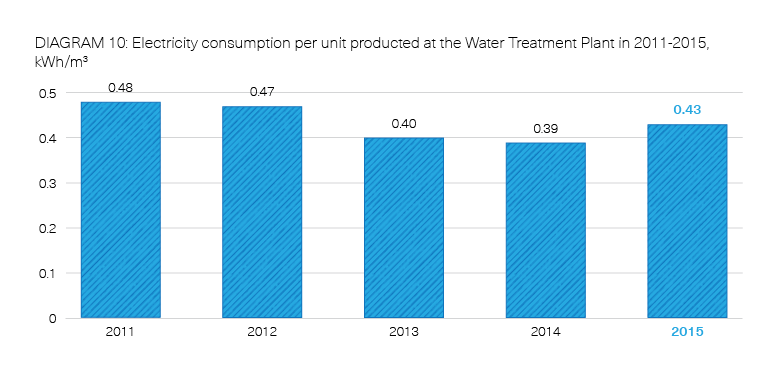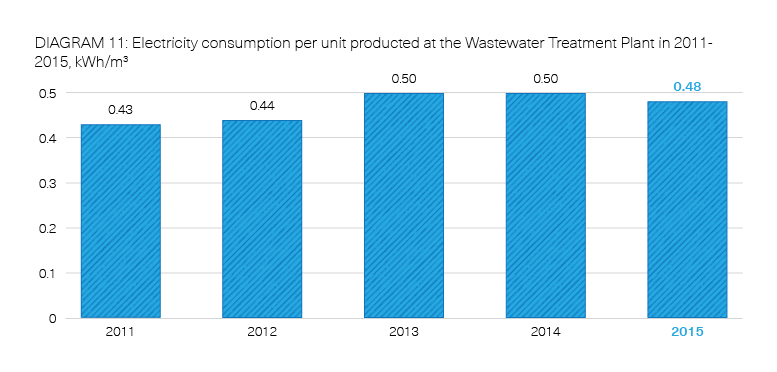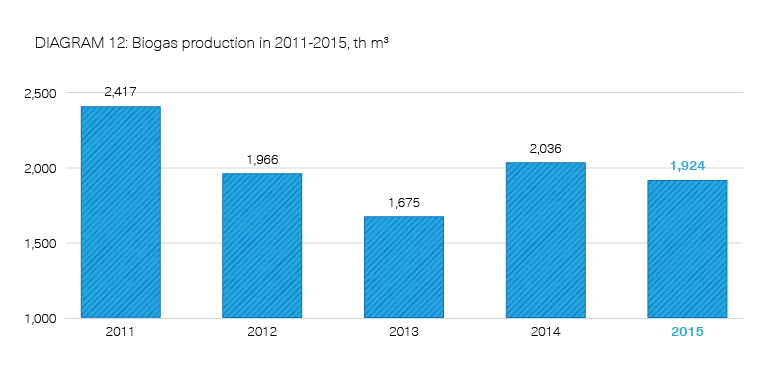Energy consumption
Electricity consumption
The majority of electricity is used to run the Company’s core processes – to operate the Water Treatment Plant, Wastewater Treatment Plant and pumping stations on the network.
In 2015, the Company’s total consumption of electricity slightly increased in comparison with the previous year, however, it has remained relatively stable over the last years. Although we have been making significant investments aimed at decreasing electricity consumption, the energy consumption is still inevitably and closely connected to the operation of our core processes. Those are in turn affected by changes in consumption and in service areas, also by the weather.
In the water treatment process, electricity is mostly used for pumping water in the various stages of the treatment process and in the water network. Significant volume of electricity is also used for producing ozone. The electricity consumption of the Water Treatment Plant has been growing due to a steady increase in the use of surface water over the years and the said consumption is also affected by the quality of raw water.
Electricity consumption in the wastewater treatment process is to a large degree impacted by the weather. In 2015, the electricity consumption slightly decreased in the Wastewater Treatment Plant due to a decreased volume of precipitation, small number of heavy showers and the improvement of energy efficiency.
Consumption of heat energy
In addition to heating the premises we need heat energy to run the core processes. The Water Treatment Plant produces heat out of outsourced natural gas in its boiler house. Ädala site uses central heating also produced out of natural gas in our area. The majority of Wastewater Treatment Plant’s needs for heat energy is covered by biogas.
We produce biogas at the Wastewater Treatment Plant within the process of digesting sludge in the digesters. We use biogas to produce heat energy on site to be used for heating the premises at the Wastewater Treatment Plant and for operating the core processes. Due to the nature of biogas production we are bound to burn some of the biogas and to use some natural gas from time to time as well (in 2015 we only used heat energy from biogas in Wastewater Treatment Plant). In 2015, we used 78% of the total volume of biogas to produce heat energy (70% in 2014) and it accounts for 68% of the total heat energy consumed in 2015.
Transportation and fuel consumption
Road transport accounts for the biggest part of our need for transportation. The Company has 94 vehicles for carrying out different operating tasks and for driving between the company locations and numerous service sites. The biggest group of vehicles is passenger cars and operating vehicles, including minivans and team vans. We have a total of 82 passenger cars and operating vehicles and a total of 12 special purpose vehicles (such as tractors, loaders, excavators, jet washing trucks etc.).
In 2015, the total consumption of fuel again slightly reduced in comparison with the previous year. We continuously try to keep the fuel consumption under control through the fuel limits set on the car users and through GPS-tracking devices. Part of the cars have been transferred to shared use so that as many people as possible would be able to use the cars to deliver their work duties and save costs.
The number of business trips made by our staff in and outside Estonia is relatively low. In planning the travel routes we follow the principle of always choosing the cheapest option. The most frequent destinations of business trips outside Estonia are the United Kingdom and Finland, to where our staff usually travels by plane and by boat. Other means of transport (e.g. bus and train) are used very little.





